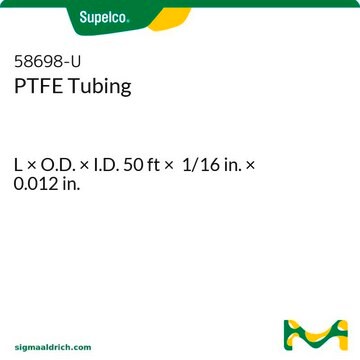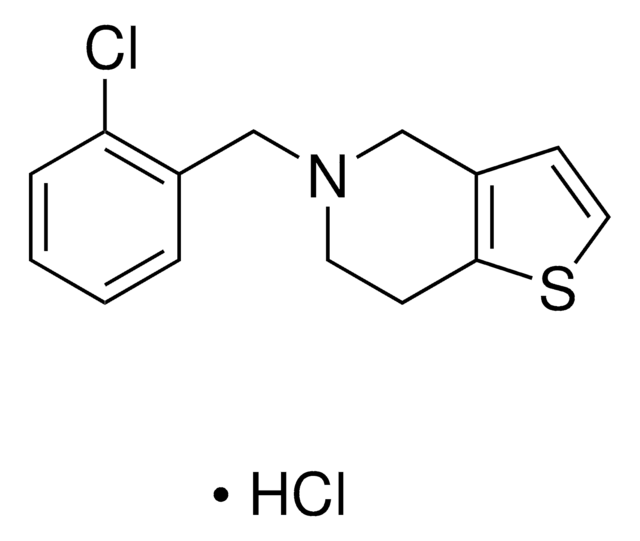71376
Sodio cloruro
BioUltra, for molecular biology, ≥99.5% (AT)
Sinonimo/i:
NaCl, Salgemma
About This Item
Prodotti consigliati
Grado
for molecular biology
Livello qualitativo
Tensione di vapore
1.33 (1.00 mmHg) at 865 °C hPa
Nome Commerciale
BioUltra
Saggio
≥99.5% (AT)
Stato
solid
Disponibilità
not available in (Sales restrictions may apply)
tecniche
mass spectrometry (MS): suitable
western blot: suitable
Impurezze
DNases, none detected
RNases, none detected
insoluble matter, passes filter test
phosphatases, none detected
proteases, none detected
≤0.001% total nitrogen (N)
pH
5.0-8.0 (25 °C, 1 M in H2O)
Punto di fusione
801 °C (lit.)
Solubilità
H2O: 1 M at 20 °C, clear, colorless
Densità
2.16 g/cm3 at 25 °C (77 °F)
Anioni in tracce
bromide (Br-): ≤50 mg/kg
hexacyanoferrate(II) ([Fe(CN)6]4-): ≤1 mg/kg
iodide (I-): ≤10 mg/kg
phosphate (PO43-): ≤5 mg/kg
sulfate (SO42-): ≤200 mg/kg
Cationi in tracce
Al: ≤5 mg/kg
As: ≤0.1 mg/kg
Ba: ≤5 mg/kg
Bi: ≤5 mg/kg
Ca: ≤10 mg/kg
Cd: ≤5 mg/kg
Co: ≤5 mg/kg
Cr: ≤5 mg/kg
Cu: ≤5 mg/kg
Fe: ≤1 mg/kg
K: ≤50 mg/kg
Li: ≤5 mg/kg
Mg: ≤5 mg/kg
Mn: ≤5 mg/kg
Mo: ≤5 mg/kg
Ni: ≤5 mg/kg
Pb: ≤5 mg/kg
Sr: ≤5 mg/kg
Zn: ≤5 mg/kg
Stringa SMILE
[Na+].[Cl-]
λ
1 M in H2O
Assorbanza UV
λ: 260 nm Amax: ≤0.01
λ: 280 nm Amax: ≤0.01
Compatibilità
suitable for component for culture media
suitable for molecular biology
applicazioni
genomic analysis
InChI
1S/ClH.Na/h1H;/q;+1/p-1
FAPWRFPIFSIZLT-UHFFFAOYSA-M
Cerchi prodotti simili? Visita Guida al confronto tra prodotti
Descrizione generale
Applicazioni
- as a component of buffer solution to prepare the pH solutions for open-circuit potential and cyclic voltammetry
- in the preparation of Bold’s basal medium (BBM)
- as a component of transcription and annealing buffer
- to maintain osmotic balance and ensure the purity and stability of the isolated extracellular vesicles (EVs)
- as a buffer for the lamination of lateral flow strips in the fabrication of lateral flow devices
Azioni biochim/fisiol
Caratteristiche e vantaggi
- Suitable for molecular biology and biochecmial research
- Free from DNase, RNase, NICKase and protease
- Tested to confirm low levels of heavy metal contamination, ensuring suitability for various applications.
- Tested for the presence of Anionic and Cationic traces
Altre note
Prodotto comparabile
Codice della classe di stoccaggio
13 - Non Combustible Solids
Classe di pericolosità dell'acqua (WGK)
WGK 1
Punto d’infiammabilità (°F)
Not applicable
Punto d’infiammabilità (°C)
Not applicable
Dispositivi di protezione individuale
Eyeshields, Gloves, type N95 (US)
Scegli una delle versioni più recenti:
Possiedi già questo prodotto?
I documenti relativi ai prodotti acquistati recentemente sono disponibili nell’Archivio dei documenti.
I clienti hanno visto anche
Il team dei nostri ricercatori vanta grande esperienza in tutte le aree della ricerca quali Life Science, scienza dei materiali, sintesi chimica, cromatografia, discipline analitiche, ecc..
Contatta l'Assistenza Tecnica.



